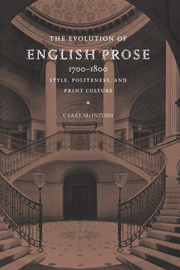Book contents
- Frontmatter
- Contents
- Preface
- 1 The ordering of English
- 2 Literacy and politeness: the gentrification of English prose
- 3 Testing the model
- 4 Loose and periodic sentences
- 5 Lofty language and low
- 6 Nominal and oral styles: Johnson and Richardson
- 7 The New Rhetoric of 1748 to 1793
- 8 The instruments of literacy
- 9 Politeness; feminization
- 10 Style and rhetoric
- Epilogue: language change
- References
- Index
7 - The New Rhetoric of 1748 to 1793
Published online by Cambridge University Press: 18 December 2009
- Frontmatter
- Contents
- Preface
- 1 The ordering of English
- 2 Literacy and politeness: the gentrification of English prose
- 3 Testing the model
- 4 Loose and periodic sentences
- 5 Lofty language and low
- 6 Nominal and oral styles: Johnson and Richardson
- 7 The New Rhetoric of 1748 to 1793
- 8 The instruments of literacy
- 9 Politeness; feminization
- 10 Style and rhetoric
- Epilogue: language change
- References
- Index
Summary
Now if the Poet is of all other the most auncient Orator, as he that by good & pleasant perswasions first reduced the wilde and beastly people into publicke societies and ciuilitie of life, insinuating vnto them, vnder fictions with sweete and coloured speeches, many wholesome lessons and doctrines, then no doubt there is nothing so fitte for him, as to be furnished with all the figures that be Rhetorically and such as do most beautifie language with eloquence & sententiousnes.
(George Puttenham, The Art of English Poesie: 1589)I have proposed that language-consciousness of several sorts may have discouraged the oral, incorrect modes of Swift, Arbuthnot, Mandeville, and Defoe, but encouraged the gentrified, polite, more written modes of Godwin, Burke, and Burney. I see the New Rhetoric as a force for language change in the eighteenth century because it allied itself with prescriptive grammar and with an emergent print culture, under the banner of “civilization,” to promote just the kind of changes we have been discussing. This hypothesis applies not only to writing but also, less stringently, to speech. That is, it finds confirmation in the new awareness of dialects, in the rage to get rid of provincial speech-patterns, in the sudden new popularity of pronouncing dictionaries and rhetorical grammars in the second half of the century.
Late eighteenth-century rhetoric encouraged both polite usage and the precision and explicitness we associate with writtenness. There are also trends in the evolution of prose that do not fit under the rubrics of politeness and literacy, but do seem related to rhetoric: the move away from loose towards periodic sentences, the move away from over concatenation towards balance and antithesis, and the new relish for what I call “purple” prose.
- Type
- Chapter
- Information
- The Evolution of English Prose, 1700–1800Style, Politeness, and Print Culture, pp. 142 - 168Publisher: Cambridge University PressPrint publication year: 1998



